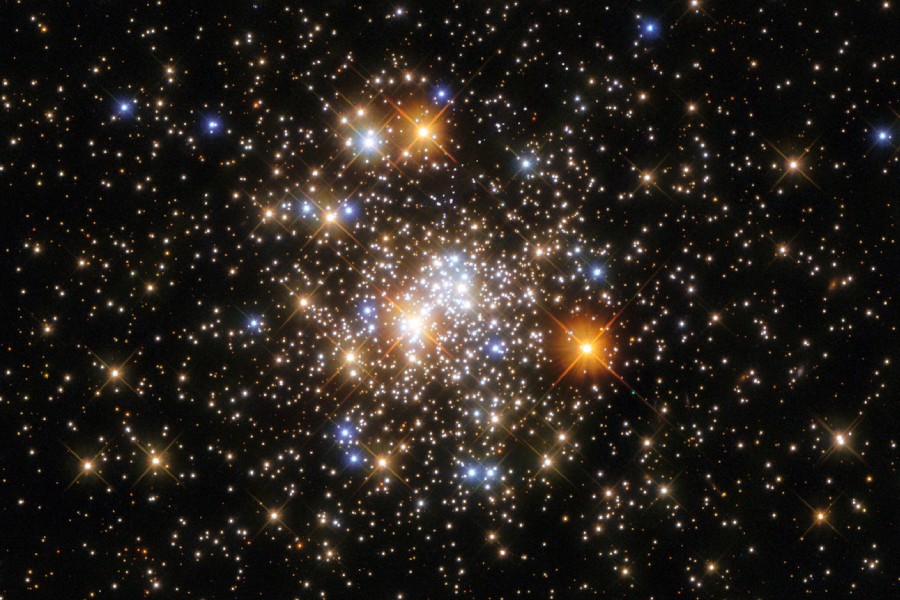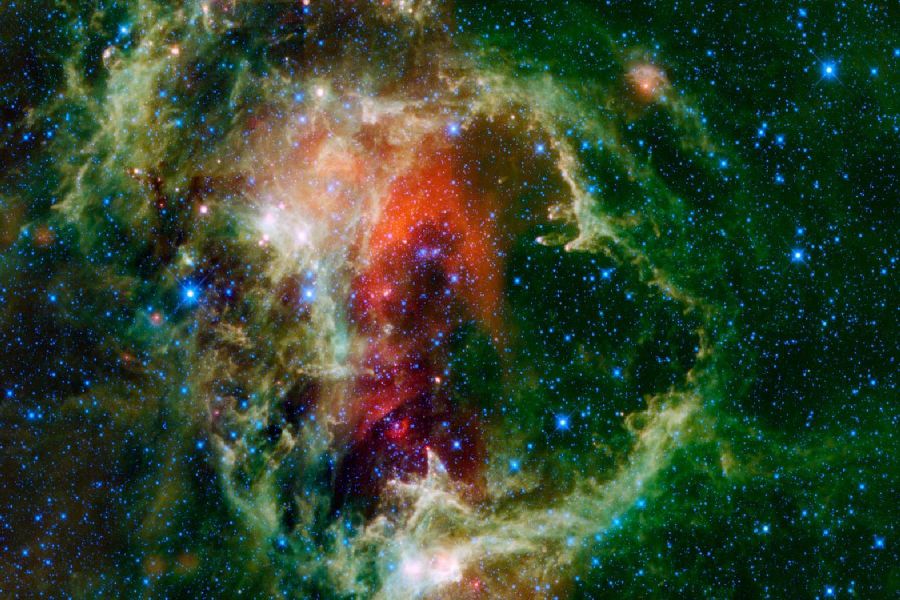When we gaze at the expanse of stars in the night sky, some shine brighter in tight-knit groups. These stars congregate against the dark canvas, called star clusters. But what is a star cluster? How are star clusters formed?
So, we will explore the different types of star clusters and how they form and evolve. We will also discuss famous clusters visible from Earth and massive ones only observable with powerful telescopes.
What Is a Star Cluster?
A star cluster is a group of stars gravitationally bound and orbiting a common center. And how are star clusters formed? The stars all formed together in giant clouds of gas and dust. Clusters range from having just a few stars to over a million stars.
There are two main types – open clusters have loosely bound stars, while globular clusters are tightly packed spherical collections. Found scattered throughout the Milky Way galaxy, star clusters provide insights into stellar lifecycles and evolution.

Characteristics of Star Cluster
Size and shape
Star clusters come in many sizes and shapes. Some are spherical, others irregular. They vary in how tightly packed the stars are.
Stars’ age and color reveal their formation timing. Dense regions birth tight clusters, while diffuse areas or weakened gravity yield looser formations over time.
Stellar composition
Some clusters have hot, young blue stars that formed recently. Others have old, red stars that formed early when the galaxy did. But cluster stars formed at the same time.
However, proximity binds the stars as kin. Despite age differences, the stars share common origins and gravitational connections in their cluster.
What Constitutes a Stellar Cluster?
Insights into stellar evolution
By delving into the study of star clusters, we gain profound insights into the evolutionary journey of stars spanning billions of years. Understanding the imprint of star formation, we decode the ages and compositions of clusters, unveiling cycles of stellar birth, life, and death.
Observing clusters unveils intricate details about the origins and demise of stars over eons, offering a perspective beyond the lifespans of individual stars. Moreover, star clusters function as expansive laboratories facilitating the comprehensive exploration of complete stellar evolution.
Clues to galactic formation
Star clusters explain how galaxies like the Milky Way formed. The ages and locations of clusters trace galactic mergers and evolution. As building blocks of galaxies, star clusters anchor our understanding of the universe’s large-scale structure across 13 billion years.
Clusters, enduring across extended epochs compared to solitary stars, emerge as celestial forensic markers. They unveil galactic mergers and historical positioning through chemical compositions and orbits, spanning ancient to present times.
Types of Star Clusters
Open clusters
Open clusters typically have just a few hundred loosely bound stars. They form within dense molecular clouds and take on irregular shapes determined by pressures in that gas cloud region.
Open star clusters are located mainly in the spiral arms and disks of galaxies where active star formation occurs. The youngest open clusters shine brightly with hot blue stars burning through their hydrogen fuel.
Older open clusters contain more red giants that have exhausted their core hydrogen after billions of years. Over time, galaxy rotation and interactions will further disperse open cluster stars.
Globular clusters
Globular star clusters are spherical collections of hundreds of thousands to over a million stars moving closely around a densely packed core. The earliest globular clusters formed around some of the first stars that developed when the Milky Way took shape over 13 billion years ago.
Globular star clusters orbit within the halos around galaxies and contain the most ancient star populations. Due to their tighter structures, globular clusters survive galaxy collisions and mergers.
Their intricate dance around galaxies over cosmic time tells an epic story. It encapsulates how large-scale cosmic structures emerged from the early universe until today.

Formation and Dynamics of Star Clusters
Formation from nebulae
Cloud collapse
Giant interstellar clouds of gas and dust, known as nebulae, are the source of star cluster formation. These stellar nurseries collapse under gravity to form new stars. The nebula mass determines if an open or globular cluster is birthed.
The density and rotation of the nebula also shape key cluster properties. Gravity causes nebula regions to contract, which seeds cluster creation.
Inheriting traits
The cluster’s form is influenced by nebula density and rotation, with composition derived from the molecular cloud. Also, star mass correlates with the initial gas density.
Furthermore, clusters inherit metal abundance, star masses, and velocity dispersion characteristics from their parent nebula. This leaves lasting imprints on their birth clouds.
Dynamic interactions
Orbital dance
Within a cluster, stars gravitationally dance together. This governs orbits around the core. Denser clusters see more interaction between stars.
Interactions redistribute energy and angular momentum over time. This slowly expands looser clusters while tightening dense cluster cores.
Also, the shared gravity environment shapes stellar movements and cluster structure through a complex, dynamic equilibrium affecting velocities over time. And closer neighbors experience more frequent stellar encounters.
Ejection
Sometimes, interactions make star velocities increase. This can exceed escape velocity and eject stars from the cluster system. Stellar escapes slowly dissolve clusters, preferentially losing low-mass stars to cluster edges. Tides and collisions erode clusters over eons.
When stars undergo close fly-bys, their trajectories can be accelerated beyond the local escape velocity threshold. This propels them out of the cluster system, leaving them to wander the galaxy in solitude indefinitely.
Evolutionary changes
Stellar life cycles
Star clusters evolve over billions of years as different mass stars age. The most massive stars exhaust their fuel quickly and perish. This alters the cluster population over time.
As high-mass stars die, the proportion of smaller, cooler red dwarfs increases. This dims and reddens the remaining cluster stars as they age.
Chemical enrichment
When the most massive cluster stars end their lives as supernovae, they eject newly forged elements into surrounding space. This chemically enriches later stars forming inside clusters.
So, heavy atoms produced in older high-mass stars recycle into next-generation cluster suns. Successive supernova eras enrich the proportions of elements like carbon, oxygen, and iron.
The heavy metal content acts as a chemical clock, revealing a cluster’s age. Earlier massive stars, now extinct, engaged in fusion, ascending the periodic table by weight. Consequently, clusters evolve, becoming increasingly metallic over eons.

Observational Significance of Star Clusters
Stellar population studies
Life cycles insights
Star clusters provide insights into stellar life cycles and evolution. Seeing many stars born together aids this stellar astrophysics research.
Additionally, studying clusters helps decipher processes from star birth to nuclear fusion phases to demise. Clusters are vital laboratories.
Population characteristics
Cluster observations provide crucial insights into stellar populations and distribution, shaping models with mass distribution and binary frequency data. This framework extends our understanding of universal stellar characteristics beyond the Sun.
Distance measurement tools
Cluster properties
Open clusters’ observable qualities help estimate cosmic distances within the Milky Way galaxy via astrophysics principles. The intrinsic luminosity of these clusters is better understood.
By comparing the apparent magnitude and brightness of clusters at various locations, astronomers can infer their remoteness based on the physics of light attenuation over distance. Understanding true luminosities enables precise space length calculations.
Distance ladder
Measuring open cluster distances allows calibration of secondary indicators like variable star pulsation rates and brightness. Precise rungs to measure the galactic distance ladder.
Once cluster distances are found, other stellar attributes with intrinsic relationships to brightness can be calibrated into reliable distance-measuring tools. Pulsating variable star period-brightness laws then extend estimates to other galaxies.
Notable Examples of Star Clusters
Pleiades open cluster
Visibility
The Pleiades is a famous open cluster visible worldwide as jewels on Taurus the Bull’s shoulder. People have observed it for thousands of years with unaided eyes. The brightness and distinctive shape of the Pleiades has captivated skywatchers for millennia, indelibly imprinting it across cultures worldwide.
Composition
The Pleiades have formed over 800 young, hot blue stars within the last 100 million years. They were born from a contracting nebula cloud rotating also. We may still see the cluster’s nebulosity. Stellar winds and radiation pressure from the hot blue stars cause the nebula remnants to glow through fluorescence and reflection.
Place and movement
The Pleiades is 400-450 light years away inside the Milky Way’s Orion Arm. Its stars march across the sky each night. Cluster motion resembles flocking birds’ fluid, graceful beauty. Perspectival changes from Earth’s movement align the cluster’s passage across the ecliptic plane each November as a striking highlight.
Omega Centauri globular
Giant of globulars
Omega Centauri shines as one of our galaxy’s biggest, brightest globular clusters. At 16,000 lightyears from Earth, it still appears striking in telescopes. Over 10 million cluster stars huddle within Omega Centauri’s core.
Ancient enigma
Its stars are over 12 billion years old, dating close to the Milky Way’s formation. But some orbital characteristics don’t match our galaxy’s rotation. Its origins remain mysterious.
Conclusion
What is a star cluster? A snapshot of stellar stories across immortal time. These cities glimpse billions of years of cosmic history through their stars gravitationally dancing since the dawn of galaxy formation.
By examining how gravity binds stars that were born together into cosmic cities, we illuminated the stellar nurseries, dynamic dances, and cosmic life cycles. These define the jeweled galactic tapestries that are star clusters.
Now, as you connect the stars overhead, let your imagination connect to the epic tales written in the images of these galaxies entwined.
